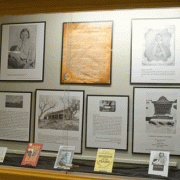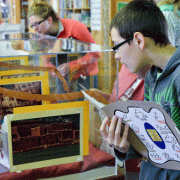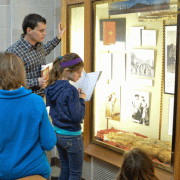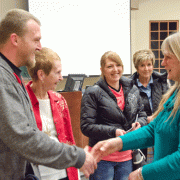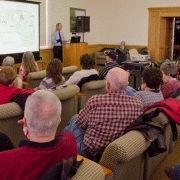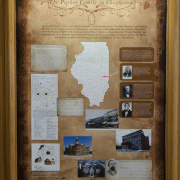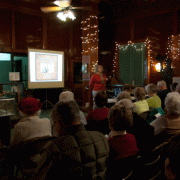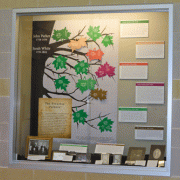Children
Tweens (10-12)
Teens
Young Adult
Adults
Intergenerational
Quanah & Cynthia Ann Parker: The History and the Legend
$2,501-5,000
Quanah & Cynthia Ann Parker: The History and the Legend was a 12-week exhibition/program series that took place at Eastern Illinois University in the spring of 2015, beginning Feb. 7. Quanah Parker is considered to be the last Comanche chief. His mother, Cynthia Ann Parker, was born around 1827 in present-day Coles County, Illinois. As a child in Texas, she was kidnapped and grew up with the Comanche tribe. Quanah and Cynthia Ann's story is well known in Texas, but few know of their connection to Illinois. This exhibit and program series was designed to explore this local connection.
Advanced Planning
We felt this project was important because it provided the campus and wider community with information about a national story that had a local beginning. This would be of particular value to Parker Family descendants and the Coles County community, who may not be aware of the rich history of their ancestors. We hoped to reach beyond campus and bring community members of all ages to the library for this series.
We began the planning two years in advance. By doing so, we were able to involve community organizations, such as the local historical society and genealogical society. We began by inviting a variety of community and campus individuals to a meeting. We followed up with them regularly and, through them, created a well-rounded series of programs, exhibits and other activities. For example, a faculty member used the exhibit for a semester-long project for EIU students studying to become teachers. These education students created curriculum materials and led a social studies activity to more than 250 Charleston fifth-graders who visited the library. By partnering with the Tarble Arts Center, we were able to participate in the annual Fifth-Grade Enrichment Program.
Marketing
We believe the marketing program was a success, as there was much buzz about the series throughout the community and beyond. Here's what we did:
- Postcard invitations to the opening of the exhibit were mailed to all EIU faculty and to dozens of community members two weeks in advance.
- A 24-page program booklet was designed to promote the series.
- Information on each individual program was included on several campus and community calendars of events.
- Large signs listing the schedule of events were posted near both library entrances.
Electronic
- The series was promoted on the library website and social media pages.
- Digital fliers appeared on every library screensaver and on digital display boards throughout campus.
- A Web page was designed to promote the series.
- A campus map and parking directory was created and posted on the Web page to aid those coming from out of town.
Media
- A full-page feature story with photos was published in the Mattoon/Charleston daily newspaper about three weeks prior to the opening.
- Library staff promoted the program on the campus radio station in a 30-minute interview about three weeks prior to the opening.
- Articles also appeared in several other local newspapers.
- Press releases were sent to media in a seven-county radius.
Budgeting
In all, the series cost $6,583. A grant from the Illinois Humanities Council covered $2,950 of that cost.
Expenses:
- The program booklet, which was designed in house and printed by a local company, was the largest expense.
- Salaries were an expense, as many of the programs were held on the weekend and required extra student help and overtime from staff members. However, most program planning was done by library staff members as part of their job duties, and costs were absorbed by the library
- Travel and payment for the keynote speaker. However, all other program presenters donated their time.
- Fees for hosting a photo exhibit from Texas.
- The cost of producing promotional and exhibit materials.
Costs could have been cut through reduced program materials, by printing fewer program booklets, or by using less overtime (perhaps by scheduling programming during the regular work day – however, that would have limited the audience). significantly
Day-of-event Activity
This was a 10-week exhibit and program series. Various reference librarians and other staff installed the exhibit throughout the library building prior to Feb. 7.
A majority of the programs were held on Feb. 20 and 21. On Feb. 19, the chairs, tables and technical equipment were set up in the library program space. On Feb. 20 and 21, water and coffee were set up near the library program space. The evening opening program on Feb. 20 and the film screenings on Feb. 21 were held at another venue on campus. Library staff were on hand to direct guests, greet them, pass out program booklets and answer questions. One staff member and two students set up and served a variety of food items and punch. On the morning of Feb. 21, two staff members bagged individual servings of popcorn, and these were served to guests at the film screenings that afternoon. Clean-up included removal of tables and chairs and general clean-up of the program venues.
Program Execution
A total of 1,445 attended the programs, and an additional 300 elementary school students toured the exhibit. An unknown number of patrons visited the exhibit during its 10-week run. A significant snowfall occurred the night of the opening, and this limited the audience on Feb. 20 and 21; however, we were still pleased with the turnout.
Many Parker Family descendants traveled from throughout Illinois and from other states to attend. Those who couldn't make it to the programs on Feb. 20 and 21 came later in small family groups to visit the exhibit. Many community members also attended the programs (video presentations can be found here), and some community groups scheduled tours of the exhibit.
The feedback was very positive. Many thanked us for presenting a program based on community history -- a story that was new to most. Several expressed interest in reading books on the subject. Many patrons visited the library for the first time and said they were impressed with the types of programming presented here. They wanted to know what our next major program topic would be so that they could return! The community and campus support, as well as bringing in audience members from elementary school age through senior citizens, made this program a success.
Advice
Start planning early, and involve as many different segments of your community as possible. Many communities have scholars and knowledgeable citizens who are willing to donate their time and would love to be involved. Our programs were led by two Parker family members, one library staff person, and 10 EIU faculty members and students. All volunteered their time. Other library staff members helped to curate the exhibits.
Keep your programs as inclusive (rather than exclusive) as possible. Whenever possible, localize your program topic. The story of Quanah and Cynthia Ann Parker has been well-documented and researched by countless scholars and filmmakers. However, we brought something new to the story by presenting a program and exhibits focusing on the Parker Family in Coles County: Cynthia Ann's childhood, her family members and the important role the Parkers had in colonizing the region now known as Coles County. This provided a valuable local connection to what was a well-known story to many, and we found that this local story is what attracted the most interest.
Supporting Materials
- Feedback (Coming Soon!)
- Programming Librarian Facebook Group

